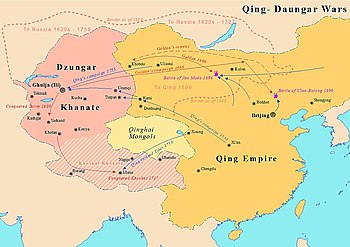
This is a timeline of the Xinjiang under the rule of the Qing dynasty.

This is a timeline of the Xinjiang under the rule of the Qing dynasty.
| Year | Date | Event |
|---|---|---|
| 1697 | ʿAbdu l-Lāh Tarkhān Beg rebels against the Dzungar Khanate in Hami[1] | |
| 1698 | Qing dynasty occupies Hami[2] |
| Year | Date | Event |
|---|---|---|
| 1720 | Amin Khoja leads a rebellion in Turpan against the Dzungar Khanate and defects to the Qing dynasty[2] |
| Year | Date | Event |
|---|---|---|
| 1732 | Dzungar Khanate attacks Amin Khoja, who takes his people to settle in Guazhou[2] | |
| 1737 | Abuse by the Dzungars cause residents of the Tarim Basin to flee to the Qing dynasty[1] |
| Year | Date | Event |
|---|---|---|
| 1755 | Dzungar–Qing Wars: ʿAbdu l-Lāh Tarkhān Beg, Amin Khoja, Yusuf Beg, and Hakim Beg Hojis join the Qing dynasty in invading the Dzungar Khanate and fighting Amursana's rebellion[2] | |
| 1757 | Revolt of the Altishahr Khojas: Khoja Burhan-ud-din and his brother Hojan rebel against the Qing dynasty in Yarkand[3] | |
| 1759 | Revolt of the Altishahr Khojas: 100,000 Qing troops enter Xinjiang, forcing the Khoja brothers to flee to Badakhshan, where the sultan has them put to death and presented to the Qing; the entirety of the Tarim Basin is conquered by the Qing dynasty[4] |
| Year | Date | Event |
|---|---|---|
| 1762 | An imperial governor-general is set up in Xinjiang, known as the Ili governor-general; Xinjiang is divided into three geographic units: the Ili and Tarbagatay regions, the eight cities south of the Tian Shan range, and Urumqi[4] |
| Year | Date | Event |
|---|---|---|
| 1777 | Population of the Tarim Basin reaches 320,000[5] |
| Year | Date | Event |
|---|---|---|
| 1814 | Hereditary posts in Xinjiang are abolished[6] |
| Year | Date | Event |
|---|---|---|
| 1826 | Population of the Tarim Basin reaches 650,000[5] |
| Ancient |
|
|---|---|
| Medieval |
|
| Early Modern |
|
| Modern |
|
| Locations | |
| Non-Han ethnicities | |
| Related | |
| Neighboring countries | |
| Miscellaneous | |
Historical polities in Xinjiang | |
|---|---|
| Pre-Mongol Empire |
|
| Mongol |
|
| Modern |
|